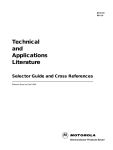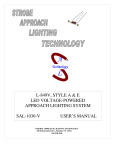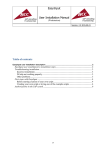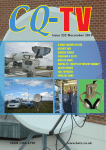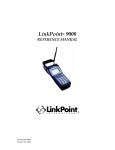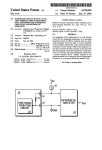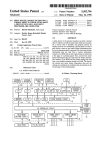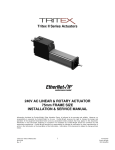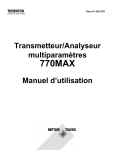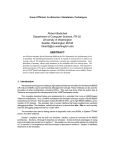Download Method and apparatus for performing a cache operation in a data
Transcript
United States Patent [19] [11] Patent Number: Ho et al. [45] [54] METHOD AND APPARATUS FOR PERFORMING A CACHE OPERATION m A DATA PROCESSING SYSTEM 5,732,405 Date of Patent: Mar. 24, 1998 5,233,700 8/1993 Takagi ................................... .. 395/400 5,263,140 11/1993 Riordan ...... .. 395/417 5,412,787 5/1995 Iorsy? et a1. ......................... .. 3951417 [75] Inventors: Yui Kaye Ho, Austin; William C. OTHER PUBLICATIONS M033“, D?PPmg Sprmgs; Joseph A‘ Motorola MC88200 Cache/Memory Management Unit Gutlel'rez’ Austm’ all of Tcx- User’s Manual; 1989,1990; pp. [73] Assignee: Motorola, Inc., Schaumburg, 111. through viii, 1-1 through 343' Primary Examiner—Eddie P. Chan [21] APPL N03 336,702 Assistant Examiner—Hiep T. Nguyen [22] Filed: Attomey, Agent, or Fzrm—Susan C. Hill Nov. 8, 1994 _ _ [57] ABSTRACT Related US. Application Data [63] 6 [2:12] [ 1 A method and apparatus for performing a cache operation in a data processing system (10). In one form, the present Continuation of Ser. No. 955,818, Oct. 2, 1992, abandoned. > invention has a “block address translation cache (BATC) ................................................. f ' ' """""""""""" " only mode” in which a reccivad logical address is Compared ' ’ to the logical addresses stored in only one of a plurality of Fleld of Search ................................. "I. address translation caches’ is. the block addt?ss 'Ianslation 395/413, 416, 418, 419, 365/49, 711/3, cache (BATC) (76). The overhead associated with loading 206, 207, 208, 209 and comparing One or more other caches (78) is not incurred. If the comparison with that one cache (BATC) (76) produces a hit, that cache (BATC) (76) supplies the address that is used as the physical address. If the comparison with that one . References Clted Us PATENT DOCUMENTS [56] 4,538,241 3951417 cache (BATC) (76) produces a miss, then a 1:1 mapping is 4,965,720 1011990 Mitchell et a1‘ 8/1985 L _ t al 395,400 taicslejtriezigd the received loglcal address is used as the physical 5,107,417 4/1992 Yokoyama ......... .. 395/500 5,155,825 10/1992 Moughanni et al. . 395/425 CVlll e 5,230,045 . .......................... -- ‘ ' ‘ 7/1993 Sindhu .................................. .. 395/425 21 Claims, 6 Drawing Sheets 536429;; TRANSLATION FILE ENABLE Q CONTROL REGISZZER LOGICAL ADDRESS / (TE) "'" MMU l vENABLE/DISABLE (MEN) BLOCK ADDRESS TRANSLATION PAGE ADDRESS TRANSLATION CACHE ‘(BATC) E CACHE (PATC) E BATC ,2 PAL ADDRESS LOGICAL ADDRESS HIT/MISS BATC ADDRESS CACHE RETRY SELECT LOGIC PATC ADDRESS 3, m (IDENTITY) * TRANSLATION BATE SELECT SELECTOR ‘ PATC SELECT E PAL SELECT PHYSICAL A PORTION OF- [EMORY MANAGEMENT ADDRESS LATCH (PAL) UNIT (THU) 54 0F >F1G.2. LIKEIISE, A PORTION OF MEMORY E MANAGEMENT UNIT ' (I110) 62 PHYSICAL ADDRESS ' ' ‘ US. Patent Mar. 24, 1998 Sheet 2 0f 6 5,732,405 ‘MEMORY MANG§§¥ENT (MW) TAGS 56 ---- ---- -- FIG454 DATA CACHE SNOOP TAGS g9 DATA MEMORY UNIT (DMU) 5i FIG-.2 MEMORY MANAGEMENT UNIT (MMU) - TAGS INSTRUCTION CACHE F1014. '62 Q5 IQ INSTRUCTION MEMORY UNIT (IMU) .42 FIG. 3 US. Patent Mar. 24, 1993 Sheet 3 of 6 5,732,405 gggfgg; TRANSLATION FILE ENABLE Q KUE) CONTROL REGISTER 82 LOGICAL ADDRESS -" MMU ENABLE/DISABLE " BLOCK (MEN) \ ‘ ADDRESS TRANSLATION TRANSLATION CACHE (BATC) Z2 -_ CACHE (PATC) '7_8 2 I, LOGICAL ADDRESS U 1! _ RETRY PAGE ADDRESS - PAL ADDRESS CACHE HIT/MISS_ BATC ADDRESS V SELECT LOGIC PATC ADDRESS V V I" 72 — 3’ , 1:1 (IDENTITY) ' TRANSLATION BATC SELECT SELECTOR PATC SELECT FIG-7 22v 7 PAL SELECT PHYSICAL A PORTION OF MEMORY MANAGEMENT ADDRESS LATCH (PAL) UNIT (mm) .54 OF -FIG.2. LIKETTISE, A PORTION OF MEMORY Z5 - MANAGEMENT UNIT‘QLHU) 62 0F FIG.3. PHYSICAL. ADDRESS FIG.4L US. Patent Mar. 24, 1998 START 1 Sheet 5 0f 6 5,732,405 MMU (MEMORY MANAGEMENT UNIT) C) ®—>v _ BATG (BLOCK ADDRESS TRANSLATION CACHE) PATC (PAGE ADDRESS TRANSLATION CACHE) PA (PHYSICAL ADDRESS) IS MMU N0 . ENABLED (MEN=1?) , \84 Y) 1:1 (IDENTITY) MAPPING PA=LOGICAL ADDRESS 86 ' ‘ ATTRIDuTES FROM CONTROL REGISTER YES DID I ‘ ' BATC N0 89 (b HIT? " 87 . 1=1 (IDENTITY) 88 YES ' MAPPING PA=DATG PA=L0GIGAL ADDRESS _ DID BATC HIT? No 91 93 PATC HIT? ' PA=BATC ADDRESS v é ATTRIBUTES ATTRIBUTES FROM FROM BATC CONTROL REGISTER - N0 (-97 v YES ATTRIBUTES FROM BATC » I ADDRESS 95 ' PA FROM I TABLE SEARCH ATTRIBUTES FROM TABLE SEARCH PA=PATC ADDRESS ATTRIBUTES FROM PATC FIG. 6 I (b , US. Patent Mar. 24, 1998 Sheet 6 of 6 4382.5 @ m2. Am mm“ @J h 0 o T m l 2 i m w 5 HE T I ! % E$05:02 E5%?8.3 gT-HV-lml v n. 2 mm: mm k AMA @Jl, E85 2 f. . A? 5,732,405 mo<z m W2 , lw .- . “motaenumg.?, HkUNRN 5,732,405 1 2 METHOD AND APPARATUS FOR PERFORMING A CACHE OPERATION IN A DATA PROCESSING SYSTEM When the ATC does not contain the requisite logical-to physical mapping, a translation “miss” (also called “no This application is a continuation of prior application Ser. No. 07/955,818, ?led Oct. 2, 1992, now abandoned. cache in order to determine the physical address that corre sponds to the received logical address. This search is often match”) occurs, and a hardware state machine or a software routine is invoked to search memory more distant than the called a “table search” or a “table walk’ because it may require the data processing system to access and read more FIELD OF THE INVENTION than one table stored in more distant memory. The present invention relates in general to a data process ing system, and more particularly to a method and apparatus for performing a cache operation in a data processing The advantage of the address translation cache (ATC) is that it saves a great deal of time. Rather than having to access tables in distant memory every time a translation is system. hardware addresses used by the semiconductor chips and required, the data processing system can quickly access the address translation cache and retrieve the correct physical address for certain selected logical addresses. A cache/memory management unit on the MC88200, available from Motorola, Inc. of Austin, Tex., has a separate memory unit for instructions and a separate memory unit for data. Each of the two memory units (instruction and data) has address translation logic containing a page address translation cache (PATC) and a separate block address electronic circuitry running the software. translation cache (BAT C). BACKGROUND OF THE INVENTION Today’s high performance data processing systems rely 15 upon sophisticated memory management systems to trans late logical addresses into real (physical) addresses. Logical addresses are the software addresses used by the program mer when writing software. Physical addresses are the In a very simple microprocessor-based system, the central processing unit (CPU) is linked directly to memory. With this type of con?guration, no memory mapping or task protection capabilities are provided, and the addresses gen erated by the CPU directly identify the physical locations to be accessed. This type of system, however, is unsuitable for multiple-task operations since there is no protection to prevent corruption of one task by another. In the prior art MC88200, there are three available trans 25 A memory unit with one or more address translation caches (ATCs) is often used to provide the address mapping and the task protection needed to construct a multitasking data processing system. The memory unit acts as an inter face between the CPU and the physical memory. The memory unit controls all accesses to physical devices, and tasks can be prevented from accessing the resources owned by other tasks. When under the control of an operating system with virtual memory capabilities, the logical—to physical mapping functions allow tasks to utilize the entire address space of the CPU without detailed knowledge of the physical characteristics of the system. The logical address is generated by the CPU and received lation modes: identity mode, PATC only mode, and both PATC and BATC mode. First, in the identity mode, neither the PATC nor the BATC is searched for a match; the physical address is the same as the logical address. Second, in the PATC only mode, both the PKI‘C and the BATC are searched for a match in order to determine the corresponding physical address. In the PAI‘ C only mode, the search of the BATC is wasted overhead and the user must load the BATC with values that will ensure that the BATC does not erroneously cause a hit. Third, in the both PATC and BATC mode, both the PATC 35 and the BATC are searched for a match in order to determine the corresponding physical address. The MC88200 has no mode in which only the BAT C is searched. Note that if both the PATC and the BATC miss, a time consuming table search operation must be performed in order to determine the 40 physical address that corresponds to the received logical address. The BATC provides logical-to-physical address transla tion for 512K-byte blocks of memory. Normally these blocks contain the operating system kernel or other high-use software. Since these blocks are high-use blocks, caching as an input by the memory unit. The memory unit, using one or more address translation caches, performs address trans lation and privilege checking for the logical address and, if the mapping is valid, drives the corresponding physical address to the data or instruction cache. Note that the address translation at the block level provides faster data cache access while avoiding ATC misses and their associ ated table searches. The PATC, on the other hand, provides corresponding physical address produced by an ATC may be logical-to-physical address translation for smaller 4K-byte ' used to access either data or an instruction, depending upon 50 pages of memory. Whether the ATC is part of a data memory unit or part of an Some data processing system applications require large instruction memory unit linear arrays of data. For example, a frame buffer for a color Generally, a memory unit contains one or more address translation caches which are used to perform address trans lation and privilege checking; and the memory unit also contains one or more caches which store actual data or instructions. Each entry in the address translation cache usually contains a logical address, a corresponding physical address, and one or more protection or control bits (collectively called attribute bits or attributes). On each memory access, an incoming logical address is 55 monitor may consist of a large linear array of data which corresponds to the pixels on the screen of the monitor. Such a frame bu?er may be too large to use pages effectively. For example, a frame buffer for a particular color monitor may require as much as 4M-bytes of memory. Such a frame buffer would require one thousand pages if each page was 4K-bytes. As a result, pages would not be an effective way to handle this large of a frame buffer. received by the memory unit and is compared to the logical address portion of each entry in the appropriate ATC in order to locate the requisite logical-to-physical mapping. When In addition, it is usually desirable for the software routines that operate on the frame buffers to be independent of the application’s hardware con?guration. As an example, a software routine which is used to modify a frame butfer is the ATC contains the requisite logical-to-physical mapping, 65 usually written so that the same software routine can be used a translation “hit” (also called a “match”) occurs, and the AT C produces the corresponding physical address. in applications having different memory sizes and/or moni tor types. 5,732,405 3 4 Thus for some applications, blocks are the most e?icient way to handle large linear arrays of data such as frame BATC only mode was then incorporated into a new approach to address translation which allowed more ?ex butters. In the prior art MC88200, the both PATC and BATC ibility to the system designer. translation mode was the mode which was normally used to The new BATC only mode eliminates the extra overhead handle large frame butfers. Unfortunately. the both PATC and BATC mode requires the extra overhead of loading and checking the PA'I‘C even though only the BALI‘C is required. Thus the software is required to properly load the PATC so required for loading and checking the PATC 78 when only the BATC 76 is being used for address translation. Note that in the prior art PATC only mode. the unnecessary overhead to load and check the BATC 76 was still required. In addition, in the new BATC only mode, a BATC miss that an erroneous hit does not occur. In addition, the hard ware performs an unnecessary check by comparing the incoming logical address to each entry in the PKI‘C. 10 defaults to a 1:1 mapping which is the same as the 1:1 mapping in identity mode. In 1:1 mapping. the physical address is the same as the logical address. The default to 1:1 SUMMARY OF THE INVENTION The previously mentioned needs are ful?lled and other advantages achieved with the present invention. In one form, the present invention is a method and apparatus for per forming a cache operation in a data processing system having a ?rst cache. In one embodiment, the method includes the step of mapping may be used in a variety of ways, thus allowing the system designer to have more ?exibility. 15 20 receiving an incoming value as an input to the ?rst cache. The method also includes the step of comparing the incom ing value to a plurality of ?rst values stored in the ?rst cache. In addition. the method includes the step of determining that a ?rst cache miss has occurred if the incoming value does 25 not match any of the plurality of ?rst values stored in the ?rst cache. And ?nally, the method includes the step of trans mitting the incoming value as an output value if the ?rst cache miss has occurred The present invention will be understood by one skilled in the art from the detailed description below in conjunction The present invention can be used in a wide variety of ways to improve the ef?ciency and ?exibility of data pro cessing systems utilizing address translation. DESCRIPTION OF THE FIGURES BRIEF DESCRIPTION OF THE DRAWINGS present invention; FIG. 2 illustrates. in block diagram form, a data memory unit 44 of FIG. 1 in accordance with one embodiment of the present invention; FIG. 3 illustrates, in block diagram form. an instruction memory unit 42 of FIG. 1 in accordance with one embodi require address translation with mapped address location which do require address translation. The ?xed address locations do not require an entry in the BATC 76. Thus, the ?xed address locations will always produce a BAT C miss and will always default to 1:1 mapping in which the physical address is the same as the logical address. The mapped address locations. on the other hand, do require an entry in the BATC 76. Thus, the mapped address locations will always produce a BATC hit in order to determine the corresponding physical address. with the accompanying drawings. FIG. 1 illustrates, in block diagram form. a data process ing system 10 in accordance with one embodiment of the For example, using the present invention the system designer may interleave ?xed address locations which do not 35 FIG. 1 illustrates a data processing system 10. Integer execution unit 12, integer execution unit 14, bit-?eld execu tion unit 16, multiply execution unit 18, divide execution unit 20, ?oating point add unit 22. pixel add execution unit 24, pixel pack execution unit 26, data unit 28, and register ?le 30 are all bi-directionally coupled to bus 34. In addition, superscalar instruction unit 36 is coupled to bus 34 in order to provide signals to bus 34. Integer execution unit 12, integer execution unit 14, bit-?eld execution unit 16, multiply execution unit 18, divide execution unit 20, ?oating point add unit 22, pixel add execution unit 24, and pixel pack execution unit 26, and data ment of the present invention; FIG. 4 illustrates, in block diagram form, a portion of 45 unit 28 are all coupled to bus 38 in order to receive signals memory management unit (MMU) 54 of FIG. 2, which is from bus 38. In addition, superscalar instruction unit 36 is identical to a portion of memory management unit (MMU) bi-directionally coupled to bus 38. Register ?le 30 is coupled 62 of FIG. 3, in accordance with one embodiment of the to bus 38 in order to provide signals to bus 38. present invention; Target instruction cache 40 and instruction memory unit FIG. 5 illustrates, in tabular form, four MMU address 50 (IMU) 42 are each bi-directionally coupled to superscalar translation modes, how the modes are activated. the source instruction unit 36. Data memory unit (DMU) 44 is of attribute bits for each mode. and the mapping for each bi-directionally coupled to data unit 28. mode in accordance with one embodiment of the present Instruction memory unit (IMU) 42 and data memory unit invention; (DMU) 44 are each bi-directionally coupled to bus interface 55 FIG. 6 illustrates, in ?ow chart form, a representation of unit 46. Bus interface unit 46 has an external bus interface the four MMU address translation modes; and 48 which is bi-directionally coupled to bus 50 and to bus 52. In one embodiment of the present invention illustrated in FIG. 7 illustrates. in partial block diagram form, partial FIG. 1, all Of data processing system 10 is located on one logic diagram form, and partial schematic diagram form. a integrated circuit. and bus 50 and bus 52 are both external portion of translation selector 70 of FIG. 4 in accordance to data processing system 10. with one embodiment of the present invention. FIG. 2 illustrates a data memory unit (DMU) circuit 44 of DESCRIPTION OF THE PREFERRED FIG. 1. DMU 44 includes a memory management unit EMBODIMENTS (MMU) circuit 54, a tags circuit 56, a snoop tags circuit 58, A more ef?cient and more ?exible approach to address 65 and a data cache circuit 60. translation was needed. A BATC only mode was developed in which only the BATC 76 is searched for a match. The FIG. 3 illustrates an instruction memory unit (IMU) circuit 42 of FIG. 1. IMU 42 includes a memory manage 5,732,405 5 6 meat unit (MMU) circuit 62, a tags circuit 64, and an instruction cache circuit 68. FIG. 4 illustrates a portion of memory management unit (MMU) 54 of FIG. 2. Note that in one embodiment of the control electrode coupled to a precharge signal. The second present invention, the portion of MMU 54 which is illus control electrode coupled to the output of NOR gate 94. P-channel CMOS transistor 104, p-channel CMOS tran sistor 106, and p-channel CMOS transistor 108 each have a ?rst current electrode coupled to the positive power supply Voltage. Transistors 104, 106. and 108 each have a second current electrode of transistor 100 is coupled to a ?rst current electrode of an N-channel CMOS transistor 102. Transistor 102 has a second current electrode coupled to ground and a trated in FIG. 4 is identical to a portion of memory man agement unit (MMU) 62 of FIG. 3. In other embodiments of the present invention. FIG. 4 may illustrate a portion of only one memory management unit, or an identical portion of 10 current electrode which is coupled to the ?rst current elec more than one memory management unit. trode of transistor 102 at a node 110. A physical address [X] value is output at node 110. N-channel CMOS transistor 112 Still referring to FIG. 4, a translation selector circuit 70 receives six control signals. three 1:1 (Identity) signals, a BATC select signal, a PATC select signal, and a PAL select signal, from a select logic circuit 72. Translation selector 70 and N-channel CMOS transistor 114 each has a ?rst current electrode coupled node 110 and a second current electrode then uses these six control signals to select which one of four coupled to ground. input address sources are used to produce the physical address which is output by translation selector 70. PATC address [X] is an input to NAND gate 116 and an input to NOR gate 118. PAT C select signal is an input to inverter 120 and an input to NOR gate 118. BATC address [X] is an input to NAND gate 122 and an input to NOR gate 124. BATC select signal is an input to inverter 126 and an input to NOR gate 124. The output of inverter 120 is an input to NAND gate 116. The output of inverter 126 is an input to NAND gate 122. The output of NAND gate 116 is coupled to a control electrode of transistor 106. The output of NAND gate 122 is coupled to a control electrode of transistor 108. The output of NAND gate 98 is coupled to a control electrode of transistor 104. The output of NOR gate 118 is coupled to a control electrode of transistor 112. The output of NOR gate Translation selector 70_ receives a PAL address from physical address latch (PAL) circuit 74. Physical address latch (PAL) 74 receives as an input the physical address which is produced by translation selector 70. Translation selector 70. block address translation cache (BATC) logic 76. and page address translation cache (PATC) logic 78 each receives a logical address as an input. BATC 76 produces a BATC address which is input to translation selector 70. PATC 78 produces a PATC address which is input to translation selector 70. In one embodiment of the present invention, BATC 76 produces two BATC hit/miss signals which are input to select logic 72. Control register ?le 80 has a control register 82. Control register 82 has a translation enable bit (TE) and an MMU enable/disable bit (MEN). In alternate embodiments of the present invention, the TB bit and the MEN bit may be located in the same register or in different registers. The TE bit and the MEN bit are received by the select logic 72 as inputs. Select logic 72 also receives a cache retry signal as an input. FIG. 5 illustrates, in tabular form, four MMU address translation modes, how the modes are activated, the source of attribute bits for each mode, and the mapping for each 124 is coupled to a control electrode of transistor 114. OPERATION OF THE PREFERRED EMBODIMENT 35 40 FIG. 6 illustrates, in ?ow chart form, a representation of the four MMU address translation modes. FIG. 7 illustrates a portion of translation selector circuit 70 of FIG. 4 in accordance with one embodiment of the bits, translation selector 70 may include N circuits such as the one illustrated in FIG.- 7. The “[X]” symbol indicated one bit of a multi-bit address. For example, PATC address DI] state will be a logic level one. Referring to FIG. 1, data processing system 10 has two memory units. DMU 44 which is used for data acquisition, and IMU 42 which is used for instruction acquisition. Other embodiments of the present invention may have only one memory unit, may have multiple memory units, or may have the functionality of multiple memory units combined into mode in accordance with one embodiment of the present invention. present invention. The circuitry in FIG. 7 is used to perform a 4:1 multiplexing operation for only one bit of address. Thus the circuit in FIG. 7 produces only one bit of physical address. In order to produce a physical address having N The terms “assert” and “negate” will be used when referring to the rendering of a signal, status bit. or similar apparatus into its logically true or logically false state, respectively. Ifthe logically true state is a logic level one, the logically false state will be a logic level Zero. And if the logically true state is a logic level zero, the logically false one complex memory unit. Referring to FIGS. 1 and 2, DMU 44 has a memory 50 management unit (MMU) 54 which receives logical addresses and control signals from data unit 28. Referring to FIGS. 1 and 3, IMU 42 has a memory management unit (MMU) 62 which receives logical addresses and control signals from superscalar instruction unit 36. represents one bit of the multi-bit PATC address. In one embodiment of the present invention, FIG. 4 55 illustrates a portion of memory management unit 54 which Still referring to FIG. 7, a 2:1 multiplexer (MUX) 90 is identical to a portion of memory management unit 62. receives the PAL select signal as a control input, and Note that the control register ?le 80 may be located any receives PAL address [X] and logical address [X] as data where in data processing system 10, as long as the control inputs. MUX 90 uses the PAL select signal to select which register ?le 80 is coupled in some manner to select logic 72. address bit to output. NOR gate 92 receives the three 1:1 In one embodiment of the present invention, the control (Identity) signals as inputs. The output of NOR gate 92 is register ?le 80 is located in register ?le 30 of FIG. 1. coupled to an input of NOR gate 94 and to an input of inverter 96. The output of inverter 96 is coupled to the input In one embodiment of the present invention, the transla of NAND gate 98. The output of MUX 90 is coupled to an tion enable bit (TE) and the MMU enable/disable bit (MEN) input of NOR gate 94 and to an input of NAND gate 98. 65 are used to help determine which address translation mode is presently selected and being used. In alternate embodi P-channel CMOS transistor 100 has a ?rst current elec ments of the present invention, other control bits could be trode coupled to a positive power supply voltage and a 5,732,405 7 8 used to help select which address translation mode is to be used. In addition. in other embodiments of the present invention, some of the address translations modes may logical address is compared to the valid stored logical addresses. In this embodiment of the present invention, a cache hit will only occur when the following two conditions are met: (1) the incoming logical address must match one of perform dilferent operations than the address translation the stored logical addresses; and (2) the incoming supervisor/user bit must match the stored supervisor/user bit modes described herein. Select logic 72 receives four input signals and produces which is associated with the stored logical address that matched. In alternate embodiments of the present invention, six output control signals as illustrated in FIG. 4. Using the four input signals. select logic 72 determines which one of no attribute bits or different attribute bits may be used as part the six output control signals to assert. There are three 1:1 (identity) output control signals because there are three input 10 of the comparison step in determining whether or not there is a cache hit. conditions that may produce the same 1:1 mapping. Trans lation selector 70 receives the six control signals from select logic 72 and uses them to control a 4:1 multiplexing opera Referring to the ?fth and sixth columns in FIG. 5. the source of the attribute bits and the logical-to-physical tion. Translation selector 70 receives four addresses, namely PAL address. logical address, BATC address, and PAT C address mapping varies depending upon the address trans lation mode. For example, in identity mode, the mapping is address. Translation selector 70 then selects one of these four addresses to output as the physical address. If one of the three 1:1 (identity) output control signals are address) and a control register is used as the source of the 1:1 (i.e. the physical address is the same as the logical attribute bits. The control register can be located anywhere in data processing system 10, and in one embodiment of the present invention, may be control register 82 in FIG. 4. In BATC only mode there are two possible mappings which may be used. depending upon whether or not there is asserted. the physical address output from translation selec tor 70 will be the same as the logical address received by translation selector 70. If the BAT C select control signal is asserted, the physical address output from translation selec a BATC bit. If BATC 76 indicates a hit. that means that tor 70 will be the same as the BATC address received by BATC 76 contains the requisite logical-to-physical mapping. translation selector 70. If the PATC select control signal is asserted, the physical address output from translation selec If BATC 76 indicates a hit. BATC 76 will also contain the requisite attribute bits and BATC 76 will be the source of the attribute bits. On the other hand, if BATC 76 indicates a miss. that means that BATC 76 does not contain the requisite tor 70 will be the same as the PATC address received by translation selector 70. And if the PAL select control signal is asserted. the physical address output from translation logical-to-physical mapping. If BATC 76 indicates a miss, the mapping is 1:1 (i.e. the physical address is the same as the logical address) and a control register, for example selector 70 will be the same as the PAL address received by translation selector 70. FIG. 5 illustrates characteristics of the-four MMU address control register 82, is used as the source of the attribute bits. translation modes used in one embodiment of the present invention. The four address translations modes are listed in the first column: identity mode. BATC only mode, PATC only mode. and both PATC and BATC mode. The second In PATC only mode, either PAT C 78 contains the requisite logical-to-physical mapping and the attribute bits, or else a 35 table search operation to more distant memory must be and third columns indicate the logic state of the translation enable bit (TE) and the MU enable/disable bit (MEN) for each of the four address translation modes. The fourth column in FIG. 5 indicates whether a BATC “hit” has occurred. A BATC hit occurs when an incoming performed in order to retrieve the corresponding physical logical address is compared with the valid logical addresses stored in BATC 76. and the incoming logical address distant memory must be performed in order to retrieve the matches one of the valid logical addresses stored in BATC 76. A BATC miss occurs when an incoming logical address address and attribute bits. In both BATC and PATC mode, either BATC 76 or PATC 78 contains the requisite logical-to-physical mapping and the attribute bits, or else a table search operation to more corresponding physical address and attribute bits. 45 is compared with the valid logical addresses stored in BATC 76, and the incoming logical address does not match any of the valid logical addresses stored in BAT C 76. A status bit, called a valid bit. is associated with each stored logical FIG. 6 illustrates, in ?ow chart form, a representation of the four MMU address translation modes. If the MU enable/disable bit (MEN) indicates that the MMU is disabled, MEN=0 in the illustrated embodiment, then the MMU will be in the identity mode and will follow the ?ow illustrated by path 84. If the MEN bit indicates that the address in BAT C 76. Each valid bit indicates whether or not 50 MMU is enabled, MEN=1 in the illustrated embodiment, then the MMU will be in one of the other three modes and its associated stored logical address is valid and thus should be compared to an incoming logical address. Note that each stored logical address in the PATC 78 also has an associated valid bit. The ?fth column in FIG. 5 illustrates the source of access 55 protection information. This access protection information is collectively called attribute bits or attributes. The above mentioned valid bit is an attribute bit. A supervisor/user bit which is used to indicate whether the associated logical PATC only mode or both BATC and PATC mode and will follow the ?ow illustrated by path 87. In the BATC only mode, following the ?ow illustrated by address is in supervisor or user space is also an attribute bit. In some embodiments of the present invention. attribute bits may be used as part of the comparison step in deter mining whether there is a cache hit or a cache miss. In some embodiments of the present invention. each incoming logi cal address has an associated incoming supervisor/user bit. The incoming supervisor/user bit is compared to the stored supervisor/user bits at the same time that the incoming will follow the ?ow illustrated by path 85. If the translation enable bit (TE) indicates that address translation is not enabled, TE=0 in the illustrated embodiment, then the MMU will be in the BATC only mode and will follow the ?ow illustrated by path 86. If the TE bit indicates that address translation is enabled, TE=1 in the illustrated embodiment, then the MMU will be in either 65 path 86, there are two possible sources for the physical address and for the attribute bits. If the logical address received by BATC 76 matches one of the logical addresses stored in BAT‘ C 76, i.e. there is a BAI‘C hit, then the. MMU will follow the ?ow illustrated by path 88 and the physical address will be retrieved from the BAT C entry which 5,732,405 10 address locations which do not require address translation matched. Likewise, the attribute bits will be retrieved from the BATC entry which matched. If the logical address received by BATC 76 does not match one of the logical addresses stored in BATC 76, i.e. there is a BATC miss, then the MMU will follow the ?ow with mapped address location which do require address translations. The ?xed address locations do not require an illustrated by path 89. The path illustrated by path 89 is the same as the path illustrated by path 84. The mapping is 1:1 (i.e. the physical address is the same as the logical address) and a control register is used as the source of the attribute bits. In prior art MMUs, a table search would be used in place of path 89 in order to determine the physical address and the attribute bits. Thus a BATC miss in BATC only mode causes the MMU to perform as if the MMU was in the identity 10 cessing systems utilizing address translation. While the present invention has been illustrated and described with reference to speci?c embodiments, further mode. This 1:1 mapping in BATC only mode may be used modi?cations and improvements will occur to those skilled in the art. For example, in alternate embodiments of the present invention. any type of architecture for data process ing system 10 may be used. The architecture illustrated in FIG. 1 is just one possible architecture that may be used. Likewise, alternate structures may be used for the portion of MMU 54 and MMU 62 illustrated in FIG. 4. Although FIG. 4 illustrates two address translation caches, BATC 76 and PATC 78, alternate embodiments of the present inven in a variety of ways, thus allowing the system designer more ?exibility in designing an application using data processing system 10. The two remaining modes both follow the ?ow illustrated by path 87. The determination as to whether BATC 76 has hit or missed may be performed before, at the same time as, or after the determination as to whether PATC 78 has hit or missed. In some embodiments of the present invention, it may be more time e?icient to perform the PATC hit/miss determination and the BAT C hit/miss determination at the same time. If BATC 76 has hit, then the MMU is in the both BATC and PATC mode and the MMU will follow the ?ow 25 may use address translation caches which are divided along boundaries other than memory blocks and memory pages. Although the illustrated embodiment uses four MMU address translation modes, as illustrated in FIG. 5, alternate MMU is either in the both BATC and PATC mode or the PATC only mode, and the MMU will follow the ?ow The both BATC and PATC mode and the PATC only mode are identical from path 93 to end point “A”. If the logical address received by PPH'C 78 matches one of the logical addresses stored in PATC 78, i.e. there is a PAT C hit, then the MMU will follow the ?ow illustrated by path 95 and the physical address will be retrieved from the PAT C entry which matched. Likewise, the attribute bits will be retrieved from the PATC entry which matched. If the logical address received by PATC 78 does not match one of the logical addresses stored in PATC 78, i.e. there is a PATC miss, then the MMU will follow the flow illustrated by path 97 and a table search operation will be required to . embodiments of the present invention may use more or fewer address translation modes. Alternate embodiments may also de?ne the characteristics of some of the address translation modes differently. The ?ow chart representation 35 Although the illustrated embodiment of the present inven translation mode being used, alternate embodiments of the present invention may use more, fewer, or no control bits. Alternatively, the control bits may not be located in a control register. bits. SUMlVIARY AND SOME ALTERNATE EMBODIMENTS In summation, the above speci?cation describes a method and apparatus for performing address translation in a data processing system 10. In one form, the present invention has a new address translation mode, called “block address 55 only one of a plurality of address translation caches, i.e. BAT C 76. The overhead associated with loading and com paring any other caches is not incurred. 1. A method for performing a cache operation in a data prising the steps of: Referring to BATC only mode, if the comparison with 60 mapping as is produced by choosing identity mode. 65 ways. For example, the system designer may interleave ?xed Although FIG. 7 illustrates one possible circuit imple mentation of a portion of translation selector 70, other alternate circuit implementations may be used. Although the present invention has been illustrated in the context of an address translation cache, the present invention may be used for cache operations other than address trans lation. It is to be understood, therefore, that this invention is not limited to the particular forms illustrated and that it is intended in the appended claims to cover all modi?cations that do not depart ?om the spirit and scope of this invention. We claim: processing system having a ?rst cache, the method com BAI‘C 76 produces a hit, then BATC 76 supplies the address that is used as the physical address. However, if the com parison with BATC 76 produces a miss, then the received logical address is used as the physical address. As a result, a BATC miss in BAT C only mode produces the same 1:1 The default to 1:1 mapping may be used in a variety of of the four MMU address translation modes illustrated in FIG. 6 may be different. tion used two control bits in a control register, namely the TB bit and the MEN bit, to help determine which address retrieve the corresponding physical address and attribute translation cache (BATC) only mode”, in which a received logical address is compared to the logical addresses stored in tion may use any number of address translation caches. Likewise, alternate embodiments of the present invention illustrated by path 91. If BATC 76 has missed, then the illustrated by path 93. entry in BATC 76. Thus, the ?xed address locations will always produce a BATC miss and will always default to 1: l mapping in which the physical address is the same as the logical address. The mapped address locations, on the other hand, do require an entry in BATC 76. Thus, the mapped address locations will always produce a BATC hit in order to determine the corresponding physical address. The present invention can be used in a wide variety of ways to improve the ei?ciency and ?exibility of data pro receiving an incoming value as an input to the ?rst cache; comparing the incoming value to a plurality of ?rst values stored in the ?rst cache; determining that a ?rst cache miss has occurred if the incoming value does not match any of the plurality of ?rst values stored in the ?rst cache; and if the ?rst cache miss has occurred, transmitting the incoming value as an output value, 5 ,732_.405 12 11 (i) receiving the incoming logical address as the input wherein the ?rst cache is an address translation cache, the to the ?rst cache; incoming value is a logical address, the plurality of ?rst values stored in the ?rst cache are logical addresses, and the (ii) comparing the incoming logical address to the plurality of logical addresses in the ?rst cache; (iii) receiving the incoming logical address as an input output value is a physical address for addressing a memory Without further table walking. 2. A method as in claim 1, wherein the data processing system is formed on a single integrated circuit. 3. A method as in claim 1. further comprising the step of: determining that a ?rst cache hit has occurred if the incoming value matches at least one of the plurality of ?rst values stored in the ?rst cache. 4. A method as in claim 3. further comprising the step of: if the ?rst cache hit has occurred, transmitting one of a plurality of second values stored in the ?rst cache as the output value. 5. A method for performing address translation in a data processing system having a ?rst cache. the method com to a second cache; (iv) comparing the incoming logical address to a plu rality of logical addresses in the second cache; and (v) determining whether a ?rst cache hit has occurred 10 based upon whether the incoming logical address matches any of the plurality of logical addresses in the ?rst cache. 13. A method as in claim 12, wherein execution of said step (ii) overlaps with execution of said step (iv). 15 14. A method as in claim 12, wherein said step of performing further comprises the step of: (vi) if the ?rst cache hit has occurred. outputting one of a prising the steps of: plurality of physical addresses stored in the ?rst cache (A) receiving an incoming logical address as an input to the ?rst cache; as a physical address. 15. A method as in claim 14, wherein said step of (B) comparing the incoming logical address to a plurality of logical addresses in the ?rst cache; performing further comprises the step of: (F) regardless of whether the ?rst cache miss has occurred. outputting the incoming logical address as the physical address if the data processing system is in the method comprising the steps of: receiving a logical address; determining which of a plurality of address translation modes is selected; (vii) determining whether a second cache hit has occrn'red (C) determining that a ?rst cache miss has occurred if the based upon whether the incoming logical address incoming logical address does not match any of the matches any of the plurality of logical addresses in the plurality of logical addresses in the ?rst cache; and 25 second cache. (D) if the ?rst cache miss has occurred, outputting the 16. A method as in claim 15, wherein said step of incoming logical address as a physical address for performing further comprises the step of: addressing a memory without further table walking. (viii) if the second cache hit has occurred, outputting one 6. Amethod as in claim 5, further comprising the step of: of a plurality of physical addresses stored in the second (E) performing steps (A). (B). (C). and (D) of claim 5 if cache as a physical address. the data processing system is in a ?rst one of a plurality 17. A method for performing address translation in a data of address translation modes. processing system having a ?rst cache and a second cache, 7. A method as in claim 6. further comprising the step of: 35 a second one of the plurality of address translation modes. 8. A method as in claim 7, further comprising the step of: if a ?rst mode of the plurality of address translation modes is selected, performing the steps of: (a) comparing the received logical address to a plurality (G) performing the following steps when the data pro of logical addresses in the ?rst cache; (b) determining that a miss has occurred if the received logical address does not match any of the plurality of logical addresses in the ?rst cache; and (c) outputting the received logical address as a physical address for addressing a memory without further tablewalking if the ?rst cache indicates that a miss has occurred; and if any mode other than the ?rst mode of the plurality of cessing system is in a third one of the plurality of address translation modes: (i) receiving the incoming logical address as the input to the ?rst cache; (ii) comparing the incoming logical address to the plurality of logical addresses in the ?rst cache; (iii) receiving the incoming logical address as an input to a second cache; and (iv) comparing the incoming logical address to a plu rality of logical addresses in the second cache. 50 9. A method as in claim 8. wherein execution of said step (ii) overlaps in time with execution of said step (iv). 10. Amethod as in claim 8, wherein said step (G) further comprises the step of: (v) indicating that a ?rst cache miss has occurred because the incoming logical address does not match any of the 55 (c) determining whether a ?rst cache hit has occurred based upon whether the incoming logical address matches any of the plurality of logical addresses in the ?rst cache; and (d) determining whether a second cache hit has occurred based upon whether the incoming logical address matches any of the plurality of logical addresses in the second cache. plurality of logical addresses in the ?rst cache. 11. Amethod as in claim 10, wherein said step (G) further comprises the step of: (vi) determining whether a second cache hit has occurred based upon whether the incoming logical address matches any of the plurality of logical addresses in the second cache. 12. Amethod as in claim 7, further comprising the step of: (G) performing the following steps when the data pro cessing system is in a third one of the plurality of address translation modes: address translation modes is selected, performing the steps of: (a) comparing the received logical address to the plu rality of logical addresses in the ?rst cache; (b) comparing the received logical address to the plu rality of logical addresses in the second cache; 18. A circuit for performing address translation in a data 65 processing system, the circuit comprising: a ?rst cache circuit for receiving a logical address, for comparing the logical address to a ?rst plurality of 5,732,405 14 13 for outputting a ?rst cache address in response to the a ?rst cache circuit for receiving a logical address, for comparing the logical address to a ?rst plurality of logical address matching one of the ?rst plurality of logical addresses stored in said ?rst cache circuit, and logical addresses stored in said ?rst cache circuit, and for outputting a ?rst cache address in response to the logical addresses; logical address matching one of the ?rst plurality of a second cache circuit for receiving the logical address, for comparing the logical address to a second plurality of logical addresses stored in said second cache circuit, logical addresses; and for outputting a second cache address in response to the logical address matching one of the second plurality of logical addresses; 10 control means for determining which one of a plurality of address translation modes is selected, said control means having a control value; and a logic means, coupled to said ?rst cache circuit, to said second cache circuit, and to said control means, said plurality of logical addresses; a storage circuit for storing a previous physical address; a control register ?le for storing a control value; a control circuit, coupled to said control register ?le, said control circuit determining which one of a plurality of address translation modes is selected in response to logic means for receiving the logical address, the ?rst cache address, and the second cache address, said logic means for selecting, based upon the control value, receiving the control value from said control register ?le; which one of the logical address, the ?rst cache a plurality of control signals, provided by said control circuit, said plurality of control signals having a unique address, and the second cache address to output as a physical address for addressing a memory without further tablewalking, said logic means outputting the logical address as the physical address when both the control value is a ?rst value and the logical address does not match any of the ?rst plurality of logical logic state for each of the plurality of address transla tion modes; and a translation selector circuit, coupled to said ?rst cache circuit for receiving the ?rst cache address, coupled to said second cache circuit for receiving the second cache addresses. 19. The circuit for performing address translation in a data processing system according to claim 18, further compris mg: a second cache circuit for receiving the logical address, for comparing the logical address to a second plurality of logical addresses stored in said second cache circuit, and for outputting a second cache address in response to the logical address matching one of the second 3O address, coupled to said storage circuit for receiving the previous physical address, and coupled to said control circuit for receiving said plurality of control signals, in response to receiving said plurality of control signals, a processing unit, coupled to said ?rst and second cache said translation selector circuit selecting which one of circuits, said processing unit producing the logical the logical address, the ?rst cache address, the second cache address, and the previous physical address to address. 20. The circuit for performing address translation in a data processing system according to claim 19, further compris ing: a bus coupled to said processing unit, to said ?rst cache circuit, and to said second cache circuit, said bus for transferring the logical address to both said ?rst and second cache circuits. 35 output as a current physical address, said translation selector circuit outputting the logical address as the current physical address for addressing a memory with out further tablewalking when a ?rst one of said plurality of address translation modes is selected and the logical address does not match any of the ?rst plurality of logical addresses. 21. A circuit for performing address translation in a data processing system, the circuit comprising: * * * * *




















